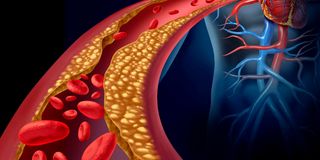How to reduce your risk of getting a blood clot

An unhealthy artery with blood clot.
What you need to know:
- Concerningly, with technological advances and shifting work patterns, many of us lead sedentary lifestyles, increasing our risk of thrombosis.
- Do you sit for a long period to work or watch TV? You could be at a higher risk of getting the condition.
Thrombosis, commonly known as blood clotting, is a life-threatening condition. Globally, one in four people dies from thrombosis-related causes, making it one of the leading causes of death.
Concerningly, with technological advances and shifting work patterns, many of us lead sedentary lifestyles, increasing our risk of thrombosis. Do you sit for a long period to work or watch TV? You could be at a higher risk of getting the condition.
This is because when we sit for long, it results in the pooling of blood in the veins, leading to clot formation, known as deep vein thrombosis. These clots can then break off and travel to other parts of the body, causing harmful effects. For instance, if a clot travels to the lungs, it leads to a potentially deadly condition called pulmonary embolism.
Globally, one in four adults does not meet the recommended levels of physical activity. The goal of taking 10,000 steps is widely circulated, but even taking 7,000 steps a day can have a statistically significant positive impact on your health. According to multiple health experts, if you’re moving less than this, it is important to walk more. Steps can be tracked and monitored on most smartphones and watches.
Crucially, even when living a generally active life, time spent sedentary poses a risk to health. The World Health Organization states that we should limit the amount of time spent being sedentary. Replacing sedentary time with physical activities provides many health benefits.
If you frequently sit in front of a screen, you may experience symptoms such as difficulty sleeping, low energy, poor posture, weight gain, lack of focus, constipation, tight hips and hamstrings, stiff neck and shoulders, and back pain.
If you’re experiencing any of these symptoms, it is vital to take action to increase physical activities. Reducing your risk of thrombosis does not require a drastic life overhaul; a few simple changes can increase your chances of a healthy life.
We all need to make a conscious effort to introduce exercises such as walking into our everyday lives. Make it a daily habit to move more—the less you keep your body in a static position throughout the day, the better your chances for living a healthy life.
Here are five easy ways to help you move more:
1) Take intentional breaks throughout your day. Whether it’s stepping outside for a few minutes, engaging in a conversation with a colleague, or going for a short walk to grab a snack or beverage, your body will thank you later.
It’s important to recognise that it’s the cumulative effect of these small movements that truly matters. The key is to integrate movement into every aspect of your life.
2) Prioritise walking more. There are many ways to increase the number of steps you walk and achieve the goal of 7,000 steps per day. Consider having physical meetings instead of virtual ones, opt for the stairs instead of elevators, park a bit farther away from your destination, and schedule a dedicated 15 to 30-minute walk each day.
3) Additionally, incorporate more exercises into your routine. Take advantage of standing breaks or leisure time and engage in exercises or stretches. Dedicating a short period of time to exercise or stretching can have a positive impact on your overall health. You can find yoga or stretching videos on platforms like YouTube, which effectively help release stress and relieve muscle tension. Alternatively, challenge yourself to perform simple exercises such as five lunges intermittently across the day.
4) For a fun and lively approach, organise dance breaks with colleagues or friends. While it may seem silly, dancing together can bring joy, boost positive energy and significantly reduce the risk of thrombosis.
5) Lastly, make it a habit to stand more. Try to stay in motion whenever possible— stand up while on the phone or go for a walk during your work breaks.
By making these changes a daily habit, not only will you reduce your chances of thrombosis, but it can also have a positive impact on your mental and physical health. Movement releases endorphins, which boost energy levels, and serotonin that uplifts mood.
Dr Ddungu is a haematology consultant




